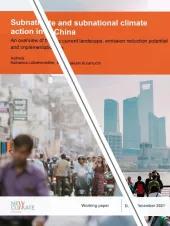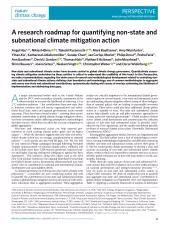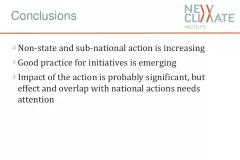This study aims to obtain enhanced understanding of subnational (e.g. cities and subnational regions) and non-state (e.g. companies) actors’ action on GHG emissions reductions in the European Union (EU). Specifically, we present an overview of findings in the recent literature on (i) landscape of sub/non-state action, (ii) interactions between EU policy making and sub/non-state actors, (iii) potential GHG emissions reductions additional to the reductions expected under national policies, and (iv) progress towards their own short- to mid-term targets and long-term goals. This report focuses on the EU, where sub/non-state climate action is significant.
Main Findings:
This working paper presents an overview of key findings from literature:
1. Landscape
Sub/non-state action is increasingly significant in the EU. 40% of the 2016 EU GHG emissions are covered by individual actors’ targets, including cities, regions and companies. The number of net-zero emissions pledges is also increasing rapidly among EU sub/non-state actors; as of October 2020, subnational net-zero targets already cover 36% of the EU’s total population. In addition, over 130 international cooperative initiatives (ICIs) focus on GHG mitigation across all sectors in the EU with ambitious, aspirational targets.
2. Mitigation potential & interactions
Sub/non-state actors could make significant contributions to GHG emission reductions in the EU. This mitigation potential can however not be isolated from national or EU-level climate ambitions; the GHG emission reductions can only be realised in coordination with national and EU-level policies. The high GHG emission reduction potential shows that there is willingness to act on the ground and that more ambition is possible, but enhanced collaboration between sub/non-state actors and national or EU-level policymakers is needed.
3. Progress
So far, we have found limited information about the progress of sub/non-state climate actors toward their targets and goals. However, substantial outputs have been delivered by initiatives aiming for indirect contributions to GHG emission reductions and literature indicates that individual European cities have made good progress towards their 2020 targets.








